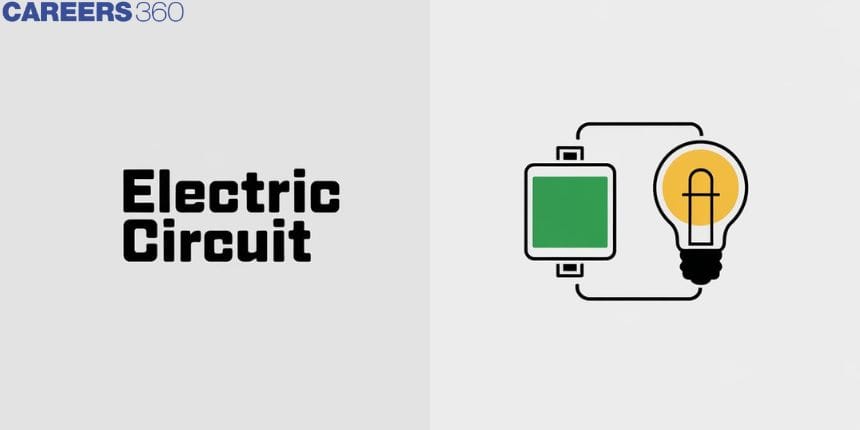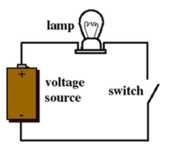Electric Circuit - Definition, Types, Diagram, FAQs
An electric circuit is the path or loop by means of which the flow of electric current is possible in the power, which drives devices used daily, like lighting, telephones, or household appliances. All these major elements working in concert include power sources, conductors, and loads to make our electronics operational. The types of circuits include series circuits and parallel circuits; each has its application in real life. Understanding electric circuits is of immense importance since it underpins almost all of modern technology, from the smallest household item to the industrial machinery that is operated for a variety of purposes.
JEE Main/NEET 2027: Physics Important Formulas for Class 10
NEET 2025: Mock Test Series | Syllabus | High Scoring Topics | PYQs
JEE Main: Study Materials | High Scoring Topics | Preparation Guide
JEE Main: Syllabus | Sample Papers | Mock Tests | PYQs

What is an Electric Circuit?
Electric circuit definition: A channel through which electric current flows is known as an electric circuit. An electric circuit can also be a loop if it is a closed path (both ends are connected). Because of the closed electronic circuit, electric current can flow freely. An open electronic circuit is one in which the passage of electrons is interrupted because the electronic circuit is broken. An open electronic circuit does not allow electric current to flow.

It's crucial to understand the fundamental components of an electric circuit. A source, a switch, a load, and a conductor make up a simple electric circuit. The following are the functions of these parts:
- The term "cell" refers to a device that is used to supply electric current.
- It's a resistor as a load. It may be a light bulb that illuminates when the electronic circuit is activated.
- Conductors: Copper wires with no insulation are used as conductors. The wire transfers current from the power source to the load on one end and from the load to the power source on the other.
- Switch: A switch is a component of an electronic circuit that regulates the flow of current through it. Its purpose is to close or open the electronic circuit.
The two basic properties of an electric circuit are current and voltage. The method of determining current and voltage in any element of an electric circuit is known as electric circuit analysis.
Current I flows through the simple circuit as a result of the entire circuit being electric, and a potential drop of V volts is created across the resistor.
Also, read -
- NCERT Solutions for All Subjects
- NCERT Notes For All Subjects
- NCERT Exemplar Solutions for All Subjects
Electric Circuit Symbols
Every part and product of an electric circuit has a symbol. Given below are the symbols of the parts that are present in an electric circuit.

Electric circuits Types
Electric circuits are divided into two categories.
- Series circuit
- Parallel circuit
Series circuit-
There is only one way for electrons to flow in a series circuit. At the same time, the complete circuit is closed or open. The fundamental disadvantage of a series electric circuit project is that there is no current flow in all about circuits in the event of a circuit break because the entire power circuit is open. If several light bulbs are connected in a series circuit, for example, if one light bulb fails, the others will also fail.

Parallel circuit-
Distinct components of the circuit are connected across different branches in a parallel form of an electric circuit model. As a result, electron flow happens in multiple stages. If a circuit break occurs in one path, the electric current continues to flow in other paths. Parallel circuits are used in household appliance wiring, so if one light bulb goes out, the other will continue to work.

Electric Circuit Formula
| Quantity | Formula | Notations |
| Electric current | $I=\frac{Q}{t}$ | I is the current, $t$ is the time period, $R$ is the resistance |
| Resistance | $R=\rho \cdot \frac{L}{A}$ | R is the resistance, $\rho$ is the resistivity value of the wire L is the length of the wire A is the cross-sectional area |
| Voltage | $\Delta V=I . R$ | $\Delta \mathrm{V}$ is the electric potential difference |
| Power | $P=\frac{\Delta E}{t}$ | $P$ is the power |
| Series circuit | $R_{e q}=R_1+R_2+R_3+\ldots$ | Req is the total resistance of the resistors placed in series, $\mathrm{R}_{\mathrm{l}}, \mathrm{R}_{2 \ldots}$ are the resistors placed in series |
| Parallel circuit | $\frac{1}{R_{e q}}=\frac{1}{R_1}+\frac{1}{R_2}+\frac{1}{R_3}+\ldots$ | Req is the total resistance of the resistors placed in parallel $\mathrm{R}_{\mathrm{l}}, \mathrm{R}_2 \ldots$ are the resistors placed in parallel |
Domestic Electric Circuit Model
- The main supply, sometimes known as mains, provides the electricity that we receive in our homes.
- It can be provided by either overhead or underground wires.
- In residential circuits, there are three types of wires: Earth Wire, Live Wire, and Neutral Wire.
- Earth Wire: Earth wire is usually a light green tint. It is linked to a metal plate placed in the ground near the house, which ensures the protection of metallic-bodied gadgets and appliances. To avoid shocks and damage, when a charge leak occurs in the metallic body, the charges are transported to the ground.
- The positive conductor or wire, which is usually red in colour, is known as the live wire.
- The negative conductor or wire, which is usually black in colour, is known as the neutral wire.
- In our country, the potential difference (or voltage) is delivered at 220V.
- Our house's electric current initially passes through a circuit known as a fuse. The fuse melts if there is a high voltage, overloading, voltage fluctuation, or short circuit, limiting the current supply and preventing the high voltage from reaching the electric appliances.
- The meter board distributes these cables to various electric appliances throughout the house.
- For domestic use, there are two types of electric circuits:
- 15 A: Appliances have a greater wattage rating. (such as geysers, air conditioners, and refrigerators)
- 5 A: Appliances with lower wattage ratings. (such as televisions, fans, and light bulbs)
Precautions From Electric Circuit
- For domestic wiring, always use high-quality wires with adequate insulation and thickness. Install ISI-marked products such as plugs, switches, and sockets to get the most out of your electrical appliances.
- The wire connections should be secure and thoroughly insulated.
- Before beginning any electrical circuit repair work, you should always turn off the main supply.
- Switch off the mains supply first if a short circuit or shock occurs. Then try to completely isolate the person who has been shocked by electricity. Do not come into immediate contact with him.
- Take measures when earthing or installing a fuse for the domestic electric circuits.
Frequently Asked Questions (FAQs)
Electric circuits Types
Series and parallel circuits are the two types of circuits commonly seen in homes and other common devices.
A connection of components that may conduct electric current is known as an electric circuit. Every circuit is made to supply electricity to one or more loads. The electricity of a boombox, for example, flows to the speakers. Similarly, the light bulb receives power from a lamp.
The majority of domestic circuits are (or should be) parallel circuits. Outlets, switches, and light fixtures are connected so that the hot and neutral wires maintain a continuous circuit pathway separate from the individual devices that use the circuit.
Both of them can be equally safe. The decisive factor is the supply voltage. Parallel circuits have components that operate at equal voltages.
The first disadvantage is that if one component in a series circuit fails, the circuit as a whole fails because the circuit is broken. The second drawback is that the resistance of a series circuit increases as the number of components increases.
Also Read
29 Nov'24 09:48 AM
23 Nov'24 01:56 PM
20 Nov'24 10:32 AM
17 Nov'24 10:02 AM
17 Nov'24 09:56 AM
14 Nov'24 07:31 PM
14 Nov'24 05:59 PM
14 Nov'24 01:16 PM
14 Nov'24 12:54 PM